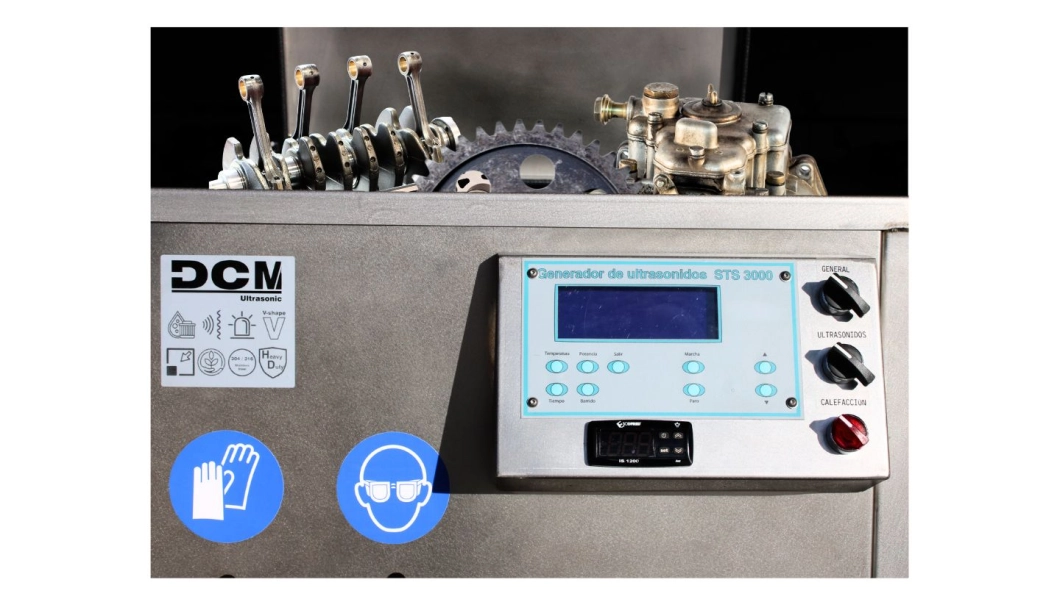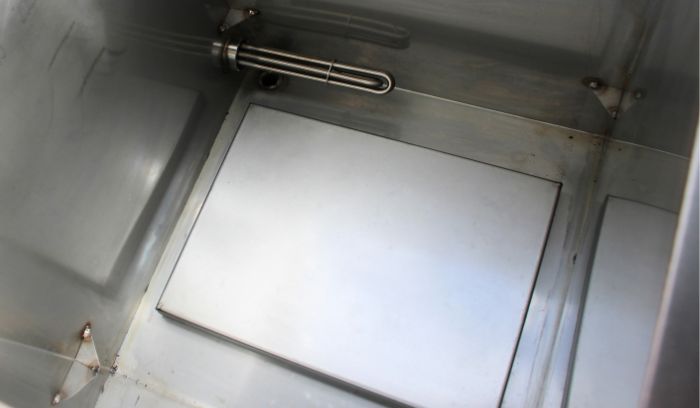Mon, 19 May 2025 14:44:04 +0200

Ultrasonic technology allows access to hard-to-reach areas, ensuring complete and thorough cleaning of each component. At DCM Ultrasonic, we have professional ultrasonic cleaners designed to provide an impeccable finish when cleaning machine parts. We offer solutions tailored to all types of workshops and specific needs. With our high-precision ultrasonic cleaning machines, worrying about dirt on parts will be a thing of the past.
Ultrasonic industrial parts washing has transformed the industry by offering a highly effective, non-invasive, and environmentally friendly cleaning solution. This technology uses high-frequency sound waves (usually between 20 and 80 kHz) generated by transducers coupled to a tank filled with liquid (water with biodegradable detergent in most cases).
The key to the process lies in cavitation: a physical phenomenon that generates millions of microbubbles that implode upon contact with the part's surface. These implosions release energy and loosen all adhering dirt in a controlled manner, even in microscopic or hard-to-reach areas, without damaging the base material.
1. Deep and homogeneous cleaning
Thanks to the cavitation effect, ultrasonic machines completely remove traces of oil, grease, carbon, swarf, pigments, scale, or any other contaminant without leaving untreated areas, even on parts with complex or internal geometries.
2. Versatility in materials and applications
This type of cleaning is compatible with a wide variety of materials: ferrous and non-ferrous metals (steel, aluminum, brass, copper, titanium), technical plastics, industrial ceramics, glass, or composites. It also adapts to small or large, delicate or resistant parts.
3. Optimization of work time
Ultrasonic cleaning cycles are noticeably faster than other traditional methods. Cleaning time can be reduced by up to 80%, which directly impacts plant productivity.
4. Low energy and product consumption
The use of neutral detergents and moderate temperatures (between 40 and 70°C) allows for efficient energy consumption and a drastic reduction in the use of polluting chemicals.
5. Greater safety and ergonomics
By eliminating the need for manual handling, hazardous solvents, or high pressure, operator safety is improved and exposure to harmful agents is reduced.
6. Automation and control
Today's ultrasonic cleaning machines integrate technologies such as PLCs, HMI displays, and programming systems to control time, temperature, frequency, and power. This allows for process traceability and standardization.

Cleaning tank for industrial parts during manufacturing at the DCM Ultrasonic workshop.
When selecting the right equipment for industrial parts washing, the following technical aspects should be considered:
1. Tank size and capacity
The tank should be sized according to the dimensions of the parts to be cleaned. There are compact tanks for small workshops and high-capacity modular systems for large-scale industrial applications.
2. Ultrasonic power and frequency
The most advanced systems can incorporate:
4. Compatibility with Automated Lines
In industrial environments with continuous production, it is essential that the ultrasonic cleaning system integrates easily with automated lines, loading/unloading robots, or conveyor belts.
DO YOU NEED A CLEANING SOLUTION FOR YOUR INDUSTRIAL PARTS?
Ultrasonic cleaning of industrial parts is a technology aligned with the sustainability goals of Industry 4.0. Reduces water consumption, avoids the use of volatile solvents, reduces hazardous waste, and improves the energy efficiency of industrial maintenance or cleaning processes.
Washing industrial parts with ultrasonic cleaning machines is an innovative, effective, and sustainable solution that meets the demands for deep cleaning, precision, and environmental protection. As industrial processes become more complex and automated, this technology is positioned as a key tool to ensure quality, operational efficiency, and regulatory compliance.
If your company is looking to improve its maintenance, cleaning, or quality control processes, integrating ultrasonic cleaning equipment can make a difference in performance and sustainability. At DCM Ultrasonic, we are at your disposal to advise you on which cleaning technology and solution best suits your needs.

News
Cleaning Machined Metal Parts With Ultrasonics
19 May de 2025
Industrial parts washing is an essential process in numerous industries such as automotive, aerospace, pharmaceutical, metallurgy, and food. The accumulation of residues such as oils, grease, machining chips, carbon deposits, pigments, oxides, or various contaminants can affect the performance, durability, and safety of industrial components. Faced with this need, ultrasonic cleaning machines have revolutionized the way parts are cleaned thanks to their efficiency, precision, and sustainability.Industrial Parts Washing with Ultrasonic Cleaning Systems
Industrial parts washing involves removing solid or liquid contaminants adhering to the surface of metal, plastic, ceramic, or other material components used in production processes. This process may be necessary at different stages of the production cycle: before assembly, after machining, for preventive maintenance, or even as part of validation in industries with high quality standards.Ultrasonic technology allows access to hard-to-reach areas, ensuring complete and thorough cleaning of each component. At DCM Ultrasonic, we have professional ultrasonic cleaners designed to provide an impeccable finish when cleaning machine parts. We offer solutions tailored to all types of workshops and specific needs. With our high-precision ultrasonic cleaning machines, worrying about dirt on parts will be a thing of the past.
Problems with Traditional Methods for Washing Industrial Parts
For decades, industrial parts have been washed using techniques such as manual brushing, solvent immersion, spray washing, or steam cleaning. While these techniques can be useful, they have several limitations:- Limited reach in complex geometries: conventional methods cannot access cavities, holes, or internal areas.
- High water and chemical consumption: the environmental impact and waste management costs increase.
- Risk to the operator: the use of aggressive solvents or high pressure can be harmful to occupational health and safety.
- Wear or damage to parts: mechanical or thermal contact can affect sensitive materials.
Ultrasonic industrial parts washing
Ultrasonic industrial parts washing has transformed the industry by offering a highly effective, non-invasive, and environmentally friendly cleaning solution. This technology uses high-frequency sound waves (usually between 20 and 80 kHz) generated by transducers coupled to a tank filled with liquid (water with biodegradable detergent in most cases).The key to the process lies in cavitation: a physical phenomenon that generates millions of microbubbles that implode upon contact with the part's surface. These implosions release energy and loosen all adhering dirt in a controlled manner, even in microscopic or hard-to-reach areas, without damaging the base material.
Main advantages of ultrasonic cleaning for cleaning industrial parts
Below, we highlight the main advantages that make ultrasonic cleaning of industrial parts the preferred option in multiple sectors:1. Deep and homogeneous cleaning
Thanks to the cavitation effect, ultrasonic machines completely remove traces of oil, grease, carbon, swarf, pigments, scale, or any other contaminant without leaving untreated areas, even on parts with complex or internal geometries.
2. Versatility in materials and applications
This type of cleaning is compatible with a wide variety of materials: ferrous and non-ferrous metals (steel, aluminum, brass, copper, titanium), technical plastics, industrial ceramics, glass, or composites. It also adapts to small or large, delicate or resistant parts.
3. Optimization of work time
Ultrasonic cleaning cycles are noticeably faster than other traditional methods. Cleaning time can be reduced by up to 80%, which directly impacts plant productivity.
4. Low energy and product consumption
The use of neutral detergents and moderate temperatures (between 40 and 70°C) allows for efficient energy consumption and a drastic reduction in the use of polluting chemicals.
5. Greater safety and ergonomics
By eliminating the need for manual handling, hazardous solvents, or high pressure, operator safety is improved and exposure to harmful agents is reduced.
6. Automation and control
Today's ultrasonic cleaning machines integrate technologies such as PLCs, HMI displays, and programming systems to control time, temperature, frequency, and power. This allows for process traceability and standardization.
What industrial parts can be cleaned with ultrasound?
Some common examples of components that benefit from this cleaning method include:- Carburetors, injectors, pumps, and valves in the automotive industry.
- Turbines, blades, aircraft parts, and engines in the aerospace industry.
- Molds, nozzles, cutting tools, and dies in the metal and plastics industries.
- Filters, sensors, precision components, and medical equipment in high-demand sectors such as pharmaceuticals.
- Rotors, stators, spindles, bearings, and gears in heavy machinery and general industry.

Cleaning tank for industrial parts during manufacturing at the DCM Ultrasonic workshop.
Key factors when choosing an ultrasonic machine for industrial cleaning
When selecting the right equipment for industrial parts washing, the following technical aspects should be considered:1. Tank size and capacity
The tank should be sized according to the dimensions of the parts to be cleaned. There are compact tanks for small workshops and high-capacity modular systems for large-scale industrial applications.
2. Ultrasonic power and frequency
- Low frequencies (20–40 kHz) are ideal for heavy soiling and tough metal parts.
- Medium-high frequencies (45–80 kHz) are recommended for delicate or high-precision parts.
The most advanced systems can incorporate:
- Filtering and recirculation of the cleaning fluid to extend its useful life.
- Mechanical or pneumatic agitation to optimize ultrasound distribution.
- Automatic drying with hot air or vacuum.
- Oil separators and particle traps.
4. Compatibility with Automated Lines
In industrial environments with continuous production, it is essential that the ultrasonic cleaning system integrates easily with automated lines, loading/unloading robots, or conveyor belts.
DO YOU NEED A CLEANING SOLUTION FOR YOUR INDUSTRIAL PARTS?
Environmental Considerations
Ultrasonic cleaning of industrial parts is a technology aligned with the sustainability goals of Industry 4.0. Reduces water consumption, avoids the use of volatile solvents, reduces hazardous waste, and improves the energy efficiency of industrial maintenance or cleaning processes.Invest in industrial parts cleaning with ultrasonic technology
In companies in the automotive sector, the use of ultrasound for cleaning injectors and EGR systems has been proven to increase engine durability and reduce maintenance costs. In the aeronautical industry, it is used to clean critical components where precision is vital. In the pharmaceutical sector, it guarantees residue- and microorganism-free cleaning of production utensils and containers.Washing industrial parts with ultrasonic cleaning machines is an innovative, effective, and sustainable solution that meets the demands for deep cleaning, precision, and environmental protection. As industrial processes become more complex and automated, this technology is positioned as a key tool to ensure quality, operational efficiency, and regulatory compliance.
If your company is looking to improve its maintenance, cleaning, or quality control processes, integrating ultrasonic cleaning equipment can make a difference in performance and sustainability. At DCM Ultrasonic, we are at your disposal to advise you on which cleaning technology and solution best suits your needs.
